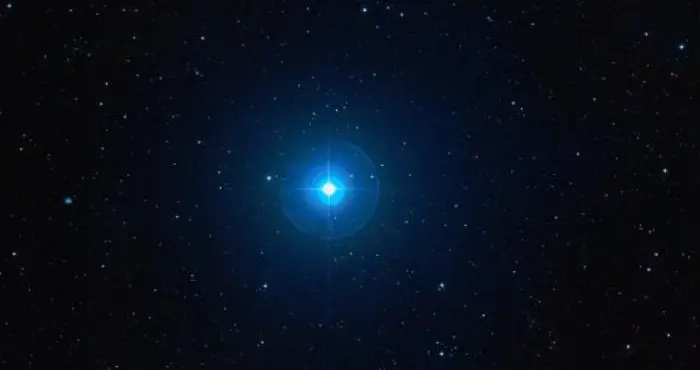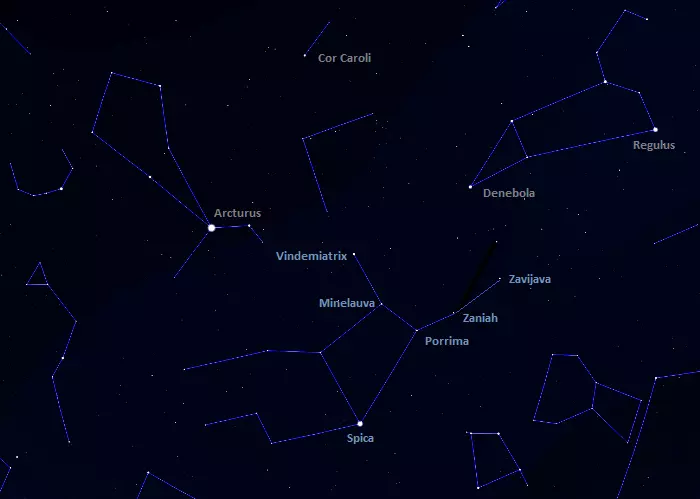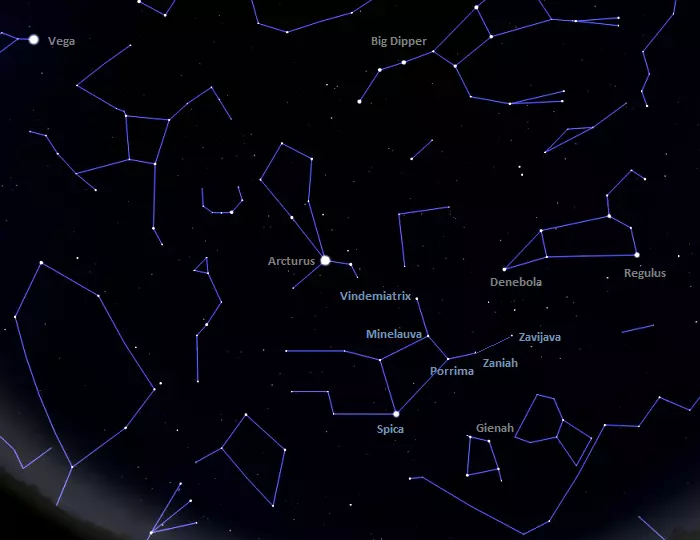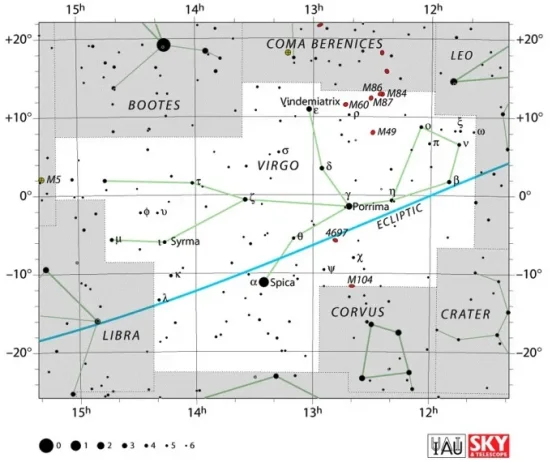Zavijava, Beta Virginis (β Vir), is an F-type main sequence star located 35.65 light-years away in the constellation Virgo. With an apparent magnitude of 3.604, it is the sixth brightest star in Virgo, after Spica, Porrima, Vindemiatrix, Heze, and Minelauva. The star is part of the Y of Virgo, an asterism that dominates the western part of the constellation.
Star type
Zavijava is a main sequence star of the spectral type F9 V. It has a mass of 1.413 solar masses and a radius of 1.681 solar radii. With a surface temperature of 6,132 K, it is 3.572 times more luminous than the Sun. The star has an estimated age of 2.9 billion years, and it is nearing the end of its main sequence lifetime.
Zavijava is a metal-rich star. Its iron content is 30% higher than the Sun’s. Solar-like oscillations were detected in the star during observations with the CORALIE spectrograph on the 1.2-m Swiss telescope at the La Silla Observatory in the Atacama Desert of Chile in 2003.

Zavijava (Beta Virginis), image: Wikisky
Facts
Zavijava is one of the six Virgo stars that form the Y of Virgo, a relatively bright asterism in the western part of the constellation. The asterism is formed by Zavijava with Spica (Alpha Virginis), Porrima (Gamma Virginis), Minelauva (Delta Virginis), Vindemiatrix (Epsilon Virginis), and Zaniah (Eta Virginis). It is commonly used to find the Virgo Cluster of galaxies, whose centre appears roughly halfway between Vindemiatrix and Denebola in the neighbouring constellation Leo. Zavijava is the star at the rightmost tip of the crooked Y. Spica appears at the base of the Y, and Porrima, Zaniah, Minelauva, and Vindemiatrix form the bowl with Zavijava.

The Y of Virgo, image: Stellarium
The nearest neighbour of Zavijava is the red dwarf Ross 119, located 5.2 light-years away. The bright Denebola is also nearby, about 8 light-years away from Beta Virginis.
Beta Virginis is a high proper motion star. It is moving at about double the velocity of the stars in its neighbourhood.
Zavijava lies only 0.69 degrees north of the ecliptic and occasionally gets occulted by the Moon. It can also be occulted by planets, but this happens only rarely. The star will next be occulted by Venus in 2069.
Name
The name Zavijava (pronunciation: /ˌzævɪˈdʒævə/) comes from the Arabic phrase zāwiyat al-cawwa’, meaning “the corner of the barker.” The name is a reference to an old Arabic asterism. It was also traditionally spelled Zavijah, Zawijah, and Zavyava.
In Arabic astronomy, Zavijava (Beta Virginis), Porrima (Gamma Virginis), Minelauva (Delta Virginis), Vindemiatrix (Epsilon Virginis), and Zaniah (Eta Virginis) formed a pattern called Al ʽAwwāʼ, meaning “the barker” or “barking (dog).”
The name Zavijava was approved by the International Astronomical Union’s (IAU) Working Group on Star Names (WGSN) on August 21, 2016.
In Chinese astronomy, Zavijava was called 太微右垣一 (Tài Wēi Zuǒ Yuán yī), the First Star of the Right Wall of Supreme Palace Enclosure. It represented 右執法 (Yòuzhífǎ), the Right Law Administrator. The Right Wall was an asterism formed by Zavijava with Sigma Leonis, Iota Leonis, Chertan (Theta Leonis), and Zosma (Delta Leonis). It was part of the Supreme Palace Enclosure, which represented the imperial court.
Location
Zavijava is relatively easy to find because it is part of a recognizable asterism, the Y of Virgo. The star marks the left wing in the constellation figure of Virgo.
The Y of Virgo can be found using the bright stars of the Big Dipper. A curved line extended from the three stars that form the Dipper’s handle first leads to Arcturus in Boötes, the fourth brightest star in the sky, and then to Spica.

The location of Zavijava, image: Stellarium
Spica appears at the base of the Y asterism, Porrima is the central star of the bowl, and there are two pairs of stars that mark the sides of the bowl. Minelauva and Vindemiatrix form the left pair, and Zavijava and Zaniah the right pair.
Zavijava is found roughly halfway between Spica and Regulus, the brightest star in Leo.
Constellation
Zavijava is located in the constellation Virgo. Virgo is one of the 12 zodiac constellations and one of the 15 equatorial constellations, visible from most places on Earth for at least part of the year. Stretching across 1,294 square degrees, it is the second largest constellation in the sky, after Hydra.
Virgo is one of the 48 Greek constellations, catalogued by Claudius Ptolemy of Alexandria in his Almagest in the 2nd century CE. In Greek and Roman mythology, it is associated with the fertility goddesses Demeter and Ceres, as well as with Dike, the Greek goddess of justice.
Virgo is best known for being home to Spica, the 16th brightest star in the sky, and to the Virgo Cluster of galaxies.

Virgo constellation map by IAU and Sky&Telescope magazine
The Virgo Cluster hosts between 1,300 and 2,000 member galaxies, including the bright elliptical galaxies Messier 49, Messier 60, Messier 87, and Messier 89, the spiral galaxies Messier 58, Messier 61, and Messier 90, and the lenticular or elliptical Messier 84 and Messier 86.
The constellation is also home to the famous Sombrero Galaxy (Messier 104), which is not a member of the Virgo Cluster. The galaxy lies near the border with the constellation Corvus (the Crow).
Notable stars in Virgo include the hot blue main sequence star Spica (Alpha Virginis), the yellow giant Vindemiatrix (Epsilon Virginis), the orange giant Kang (Kappa Virginis), the yellow-white giant Syrma (Iota Virginis), the nearby red dwarf Ross 128, and the yellow main sequence star 61 Virginis, which hosts three exoplanets.
The best time of the year to observe the stars and deep sky objects in Virgo is during the month of May, when the constellation climbs high above the horizon in the evening. The entire constellation is visible from locations between the latitudes 80° N and 80° S.
The 10 brightest stars in Virgo are Spica (Alpha Vir, mag. 0.97), Porrima (Gamma Vir, mag. 2.74), Vindemiatrix (Epsilon Vir, mag. 2.826), Heze (Zeta Vir, mag. 3.376), Minelauva (Delta Vir, mag. 3.39), Zavijava (Beta Vir, mag. 3.604), 109 Virginis (mag. 3.72), Mu Virginis (mag. 3.88), Zaniah (Eta Vir, mag. 3.89), and Nu Virginis (mag. 4.04).
Zavijava – Beta Virginis
| Spectral class | F9 V |
| U-B colour index | +0.090 |
| B-V colour index | +0.553 |
| Apparent magnitude | 3.604 |
| Absolute magnitude | 3.41 |
| Distance | 35.65 ± 0.09 light-years (10.93 ± 0.03 parsecs) |
| Parallax | 90.8945 ± 0.1934 mas |
| Radial velocity | +4.455 ± 0.0005 km/s |
| Proper motion | RA: + 740.746 ± 0.235 mas/yr |
| Dec.: -270.927 ± 0.174 mas/yr | |
| Mass | 1.413 ± 0.061 M☉ |
| Luminosity | 3.572 ± 0.052 L☉ |
| Radius | 1.681 ± 0.008 R☉ |
| Temperature | 6,132 ± 26 K |
| Metallicity | 0.20 dex |
| Age | 2.9 ± 0.3 billion years |
| Rotational velocity | 4.3 km/s |
| Surface gravity | 4.125 ± 0.010 cgs |
| Constellation | Virgo |
| Right ascension | 11h 50m 41.7185158616s |
| Declination | +01° 45′ 53.001539131″ |
| Names and designations | Zavijava, Beta Virginis, β Vir, 5 Virginis, Alaraph, Minelauva, Zavijah, HD 102870, HR 4540, HIP 57757, SAO 119076, FK5 445, BD+02°2489, AG+02 1527, LHS 2465, LFT 854, GC 16215, GCRV 7160, GJ 449, PPM 158259, PLX 2739.00, LTT 13264, NLTT 28736, JP11 2112, IRAS 11481+0202, 2MASS J11504173+0145528, UBV 10653, TYC 273-924-1, Gaia DR2 3796442680947600768, Gaia DR3 3796442680948579328, CCDM J11507+0146A, IDS 11454+0219 A, WDS J11507+0146A |